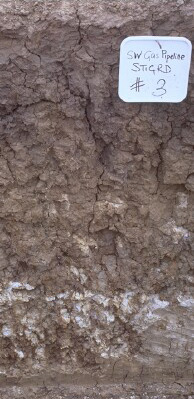SW98
Location: Batesford
Australian Soil Classification: Epihypersodic-Endocalcareous, Epipedal, Black VERTOSOL
General Landscape Description: Undulating Rises.
Site Description: Simple slope on side of open depression.
Geology: Quaternary Basalt - Newer Volcanics
Soil Profile Morphology:
Surface Soil
| Ap | 0-15 cm | Dark brown (10YR3/3); medium clay; pH 6: |  SW98 Profile - Note: Surface stripped from soil profile. |
| Subsoil | |||
| B21t | 15-45 cm | Black (7.5R2.5/1 moist); medium clay; coarse rough prismatic, parting to coarse angular blocky or polyhedral structure; slickensided surfaces; strong consistence dry; pH 8.6; gradual change to: | |
| B22ss | 45-70 cm | Dark greyish brown (10YR4/2 moist); medium clay; coarse rough prismatic structure; with much larger and more prominent slickensides than B21; pH 9.4; diffuse change to: | |
| B23ss(k) | 70-100 cm | Dark greyish brown (10YR4/2 moist); medium clay; coarse rough prismatic structure; prominent slickensides (100-300 mm); occasional soft whitish carbonate; pH 9.6; clear change to: | |
| B24kt | 100+ cm | Dark greyish brown (10YR4/2 moist); light medium clay; coarse polyhedral structure; abundant soft whitish carbonate in a clay matrix. |
Key Profile Features:
- Clay texture throughout the soil profile.
Soil Profile Characteristics:
pH | Salinity Rating | |||
Surface (A1 horizon) | Moderately Acid | Low | Non-Sodic | None1 |
Subsoil (B21 horizon) | Strongly Alkaline | Low | Strongly Sodic | Moderate-Strong |
Deeper Subsoil (at 70-85 cm) | Extremely Alkaline | High | Strongly Sodic | Moderate-Strong |

| The surface is moderately acid. The subsoil is strongly alkaline becoming extremely alkaline at depth. | Salinity rating is low in the surface and upper subsoil becoming high in the deeper subsoil. | The soil is non sodic in the surface and strongly sodic in the subsoil. | The clay content is high throughout the profile. |
Horizon | Sample Depth (cm) | pH (water) | pH (CaCl2) | EC 1:5 | NaCl % | Exchangeable Cations | |||
Ca | Mg | K | Na | ||||||
meq/100g | |||||||||
Ap | 0-15 | 6 | 5.2 | 0.16 | 6.5 | 5.8 | 0.91 | 1 | |
B21 | 20-35 | 8.6 | 7.4 | 0.32 | 0.02 | 8.9 | 11 | 1 | 6.3 |
B22 | 40-60 | 9.4 | 8.6 | 0.61 | 0.04 | 7.6 | 12 | 0.9 | 8.1 |
B23 | 70-85 | 9.6 | 8.6 | 0.67 | 0.04 | 6.8 | 12 | 0.7 | 8.7 |
Horizon | Sample Depth (cm) | Exchangeable Aluminium mg/kg | Exchangeable Acidity meq/100g | Organic Carbon % | Nitrogen % | Field Capacity pF2.5 | Wilting Point pF4.2 | Coarse Sand (0.2- 2.0 mm) | Fine Sand (0.02- 0.2 mm) | Silt (0.002- 0.02 mm) | Clay (<0.002 mm) |
Ap | 0-15 | <10 | 10 | 2.7 | 0.25 | 24.9 | 13 | 19 | 37 | 10 | 29 |
B21 | 20-35 | 15 | 25 | 9 | 46 | ||||||
B22 | 40-60 | 15 | 25 | 13 | 38 | ||||||
B23 | 70-85 | 17 | 30 | 14 | 35 |
Management Considerations:
Subsoil (B) Horizons
- The dense and coarsely structured subsoil is strongly sodic and disperses strongly in water. This will result in restricted root and water movement into the subsoil.
- The subsoil is strongly to extremely alkaline. This indicates that some nutrients (e.g. iron, manganese, copper, zinc) may be poorly available to plants.
- Tillage of cracking clay soils should be avoided if the soil is wet (i.e. wetter than the plastic limit). At such moisture conditions, excessive tillage, trafficking or over stocking could result in structural damage (i.e. compaction, smearing) occurring. Ideally tillage and trafficking should take place when the soil is drier than the plastic limit.
- When the soil is dry, heavy rains will move from soil cracks. This rapid recharge can be valuable for the survival of plants near wilting. When wet, the soil will swell and further infiltration of water will be relatively slow.
Notes:
- This profile is only 20 metres down slope from SW97 so has similar properties except for depth of soil (no weathered basalt in exposed profile) and more prominent cracking and slickenside development.
Profile Described By: Richard McEwan (February 1999).


